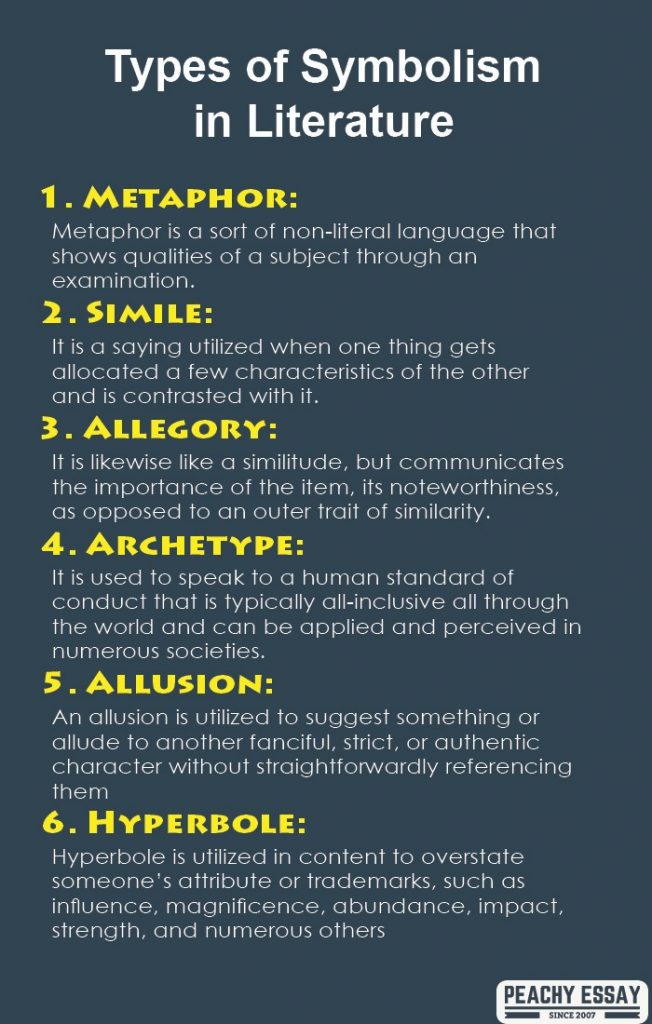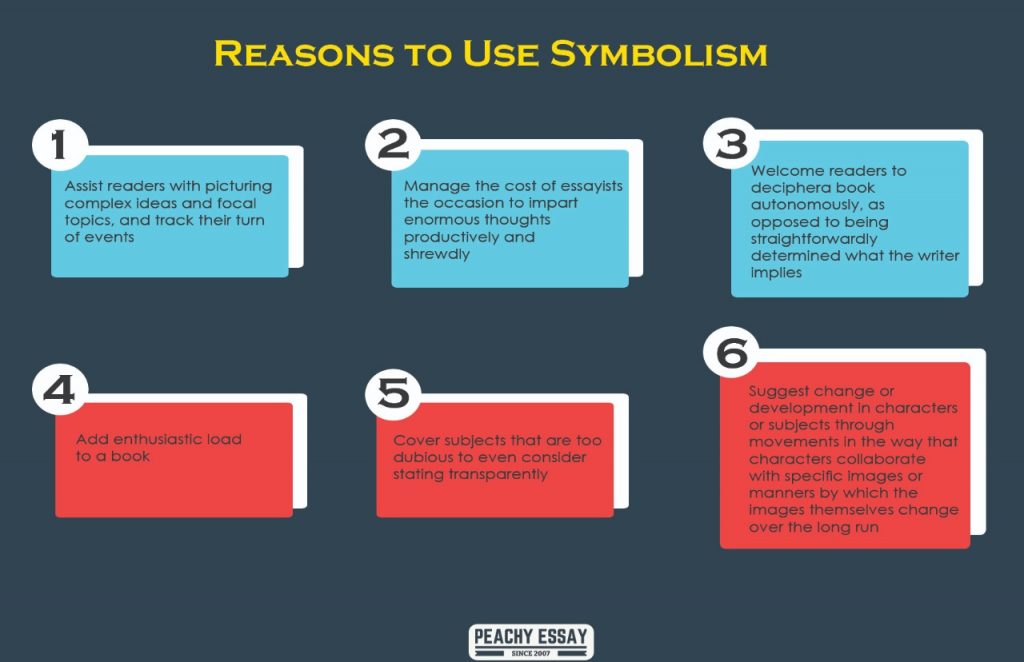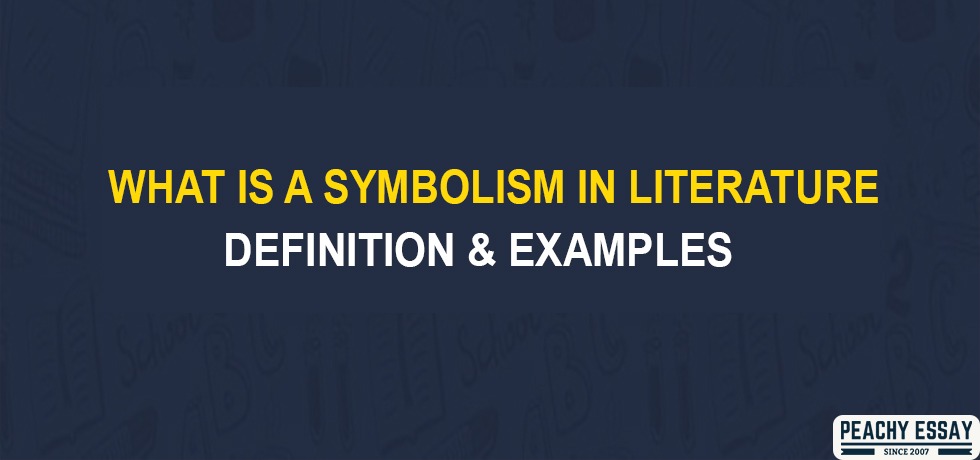In literature, symbolism is regularly utilized in writing to paint vivid scenes. It manages the cost of the essayist aesthetic articulation that replaces tasteless composition. Past that, symbolism additionally permits readers to imagine intricate or troublesome subjects.
Symbolism can be an article, individual, circumstance, occasion, or activity that has a more profound significance in the general setting past a surface agreement. At this point when utilized appropriately, it can improve a bit of composing and give further understanding to the reader.
What Is Symbolism?
Symbolism is an instrument used to give objects a more profound meaning and an alternate quality with the utilization of an image. Images are profoundly established in our discourse without us seeing them since they upgrade our discussion, make sentences expound, and embody things we talk about more distinctively.
For instance:
A dove is an image of harmony, a dark cat implies misfortune, and white banner methods a harmony offering.
Most images are all-inclusive and can be perceived by individuals from various nations and foundations. Notwithstanding, some of them are socially explicit and one should be cautious all together not to irritate anybody or be misconstrued.
In writing, images are regular characters, settings, pictures, or different themes that stand for greater thoughts. Authors regularly use images (or “imagery”) to give their work additional meaning and to make a story be about more than the occasions it depicts.
Some Key Additional Details about Symbolism
Symbolism is an artistic gadget wherein an author utilizes a certain thing—normally an actual item or phenomenon—to speak to something more abstract. A solid image generally shares a bunch of key attributes with whatever it is intended to represent or is identified with it in some alternate manner. Characters and occasions can likewise be representative. An acclaimed illustration of an image in writing happens in To Kill a Mockingbird when Atticus tells his kids Jem and Scout that it’s wrong to slaughter a mockingbird since mockingbirds cause no mischief to anybody; they simply sing. Due to these characteristics, mockingbirds in the novel represent guiltlessness and excellence, while slaughtering a mockingbird represents a demonstration of silly cold-bloodedness.
Symbolism can be extremely unobtrusive, so it isn’t in every case simple to distinguish or comprehend. It can here and there be hard to state whether a creator proposed for something to be emblematic or not. Imagery permits scholars to pass on things to their readers idyllically or in a roundabout way instead of saying them all together, which can cause writings to appear to be more nuanced and complex.
How Symbolism Is Used in Literature
Certain articles and terms connote things that are unique in relation to their literal sense. As a rule, symbolism is utilized to give further and more critical significance to occasions, articles, and characters all through the content, bring together them and give certain undertones. Writers fuse symbolism to communicate convoluted ideas outwardly and show a string of certain progressing subjects in their composition. Since, much of the time, images that are utilized are covered up in the content, they power the reader to participate in basic reasoning. It makes the reader wonder about the figurative utilization of either object as an image. In the event that the subject of a book or a paper may be touchy to specific individuals, imagery likewise proves to be useful. It can help express thoughts that a writer needs to address through the crystal of an image, instead of discussing questionable things transparently.
Another explanation an essayist may decide to utilize imagery in his work is to make various degrees of significance in his story. This significance isn’t just exacting, yet additionally more profound. It interfaces the reader with his story on an alternate, a passionate level, other than recounting the story. The reader then again, as to find these concealed representative ties and implications, since it allows them to look into the author’s mind and get a feeling of what goals he had in making them.
Basically, symbolism lets an author acquaint his crowd with an idea in a fascinating graceful manner that doesn’t part with the thought immediately; baiting the reader into his reality loaded with wonderful ramifications and confounded ties.
Types of Symbolism in Literature
There is a wide range of abstract gadgets that assist journalists with utilizing imagery in their writings. Here are the types of symbolism in literature.

-
Metaphor
Metaphor is a sort of non-literal language that shows qualities of a subject through examination with something different, their similarity or differentiation between them.
An incredible illustration of similitude can be found at the initial expressions of “As You Like It”, a peaceful parody by William Shakespeare:
“All the world’s a stage,
And all the people simply players;
They have their ways out and their entrances …”
Here, he analyzes human existence to a venue stage. Same as anything that can occur throughout everyday life, a stage can have a wide range of various plays depicted. The play will likewise be over at some point or another, equivalent to life. By making this straightforward examination, he clarifies the confounded and troublesome laws of nature, for example, human mortality. The last expression alludes to individuals’ ties and their significance in one another’s lives as “ways out” and “doors”.
-
Simile
It is a saying utilized when one thing gets allocated a few characteristics of the other and is contrasted with it. The two types are contrasted with each other with the utilization of “as” or “like”. It may sound like a metaphor, but the last gives just slight ramifications that something resembles something different, though a metaphor straightforwardly states it. An incredible illustration of a likeness can be found in “Lolita” by Vladimir Nabokov:
“Old American women inclining toward their sticks recorded towards me like pinnacles of Pisa.”
Here Nabokov says that women’s sticks help him straightforwardly to remember the pinnacle of Pisa — a structure in Pisa, Italy, that is inclined aside. This excellent likeness features the craftsman’s intricate method of communicating his contemplations, how educated and developed he is, yet above all, gives the reader another visual of how these sticks caused him to feel and how they may resemble.
-
Allegory
Another scholarly gadget that assists with utilizing symbolism is an allegory. It is likewise like a similitude, but communicates the importance of the item, its noteworthiness, as opposed to an outer trait of similarity. Through the affiliation that purposeful allegory makes with the characters recorded as a hard copy, the reader gets a feeling of how a circumstance or an issue in question fits throughout the entire existence of the world, workmanship history, or a specific culture.
A genuine illustration of allegory in writing is “Ruler of the Flies” by William Golding. There he compares society around him to a gathering of youngsters who are stuck on a remote location because of a plane accident and are attempting to survive there. The island in the book represents the world itself, the conch is an image of lawfulness, and the fire stands for destruction. Every youngster, with his job and character, speaks to a specific cultural defect, portraying individuals’ imperfections in the organizations of the religion, governmental issues, profound quality, and numerous others.
-
Archetype
An archetype is another abstract gadget used to speak to a human standard of conduct that is typically all-inclusive all through the world and can be applied and perceived in numerous societies. The model can likewise be a spot in existence, a specific topic that is shared all things considered by residents of the world. Numerous archetypes came into writing from people’s craftsmanship and fantasies.
One of the most widely recognized and acclaimed models is the hero. A portion of the qualities characterizing a legend incorporate secretive conditions of their introduction to the world, battle and demonstrating every individual who lost confidence in them off-base, awful occasions for the duration of their lives, and muddled and risky experiences. An extraordinary illustration of a paradigm is Harry Potter, the principle character of the series by J.K. Rowling. He was stranded by the coldblooded dull wizard Lord Voldemort and battled him all through the book series.
-
Allusion
An allusion is utilized to suggest something or allude to another fanciful, strict, or authentic character without straightforwardly referencing them. The utilization of mention permits a creator to convey his content utilizing elaborate language. Distinctive explanatory figures power readers to fuse their experience information and partner the character or issue being referred to with outer references.
In his book “Fahrenheit 451”, Ray Bradbury utilizes a reference to a verifiable misfortune that occurred in 79 A.D. close to the city of Pompeii, Italy, where a volcano named Vesuvius ejected and executed the whole populace, leaving the city shrouded in ashes.
“Mildred ran from the parlor like a local escaping an ejection of Vesuvius.”
By utilizing this express inference, Bradbury clarifies that Mildred was fleeing from something horrendous, as quick as possible since it would somehow have executed her — much the same as each occupant of Pompeii.
-
Hyperbole
Hyperbole is utilized in content to overstate someone’s attribute or trademarks, such as influence, magnificence, abundance, impact, strength, and numerous others. Hyperbole ordinarily has an interesting impact used to assist readers with picturing the solid purposes of the content. An illustration of metaphor would be a line from Joseph Conrad’s “Heart of Darkness”:
“I needed to sit tight in the station for ten days — an eternity.”
To demonstrate how agonizing, troubling, and debilitating it was for the character to sit tight in the station for ten days, he analyzes to an unending length of time. It was just 10 days yet felt any longer given the conditions.
Is a Symbol Purposeful or Not?
Now and again, especially when an image is unobtrusive, it’s not in every case even certain whether the writer’s utilization of symbol is deliberate, or whether the reader is providing their own importance of the content by “adding something extra to” something as a symbol. That isn’t an issue, however. Indeed, it’s a lovely aspect regarding symbols: regardless of whether symbolism can be supposed to be available in content has a lot to do with the reader’s understanding as to the essayist’s goals.
Symbol vs. Metaphor
From the start, symbol and metaphor can be hard to recognize from each other—the two gadgets permeate a book with importance past its strict sense, and both utilize one thing to represent something different. In any case, there are a couple of key contrasts among metaphor and symbolism:
Metaphors analyze two unique things by expressing that one thing is the other (e.g., your eyes are paradise). This doesn’t occur in symbolism where the connection between an image and what it speaks to isn’t expressed unequivocally and one thing isn’t supposed to be the other thing. All things considered, a symbol represents or speaks to something different.
While a representation is utilized to contrast one thing with another dependent on shared attributes, symbols don’t have to share any qualities for all intents and purpose with what they speak to. For example, Annie Proulx’s story Brokeback Mountain closes with one character taking in the smell of a shirt that was once worn by his lost love. The shirt doesn’t share any attributes for all intents and purpose with the darling—it represents him just to the extent that it once had a place with him.
For What Reason Do Writers Use Symbolism?
It’s elusive to come across writing that comes up short on any sort of symbolism. Symbolism is a significant scholarly gadget for making complex stories since it empowers essayists to pass on significant data without expressing things straightforwardly. Furthermore, the utilization of symbolism is far-reaching since it can:

Symbolism Examples
Some symbols are so anchored in a tradition that you probably haven’t given them much attention. For example:
- Brides wear white since white represents purity.
- Snakes frequently represent evil or debasement.
- Windows can speak to circumstance or opportunity. Notwithstanding, a shut window can likewise imply ensnarement.
- Apples customarily represent information, because of their importance in the Bible.
While you may not contemplate images in your regular day to day existence, in writing it is critical to observe key images to get a more profound comprehension of the work.
Images in Literature
Getting comfortable with the accompanying images can help develop your reading (or composing) experience. While these articles don’t generally convey emblematic importance in content, these are probably the most widely recognized images utilized in writing.
Rivers: In literature, rivers are ordinarily images of life. The beginning stage of waterways, typically little mountain streams, can be viewed as the beginning stage of life, while their combining point with the sea can be viewed as life’s end.
Rivers can likewise represent freedom. For instance, in Tom Sawyer’s The Adventures of Huckleberry Finn, the Mississippi River speaks to both Jim and Huck’s freedom since it offers them a break and eventually helps them through the story.
Rain: Rain generally represents resurrection or a defining moment. Like sanctification, it frequently connotes another beginning for characters who are trapped in it.
Probably the most established model comes from the Biblical story of Noah’s Arc: a fierce tempest brings pulverization, at the end of the day denotes the beginning of new life on Earth.
Winter: Winter frequently represents demise or stagnation.
In C.S. Lewis’ The Lion, the Witch, and the Wardrobe, the colder time of year season mirrors the sadness of life under the standard of the White Witch.
Spring: Spring is the period of youth, love, and resurrection. Spring is normally depicted in craftsmanship, as in Botticelli’s Birth of Venus or Primavera.
Fall/Autumn: This season for the most part connotes decrease or approaching
Summer: Ever notice that the vast majority of your number one transitioning books and motion pictures happen in summer? That is no fortuitous event. Summer is regularly emblematic for development or information.
At the point when you go over the images recorded above, ask yourself how these elective implications may find a way into the unique situation, and consider how they could give additional importance to the story.




